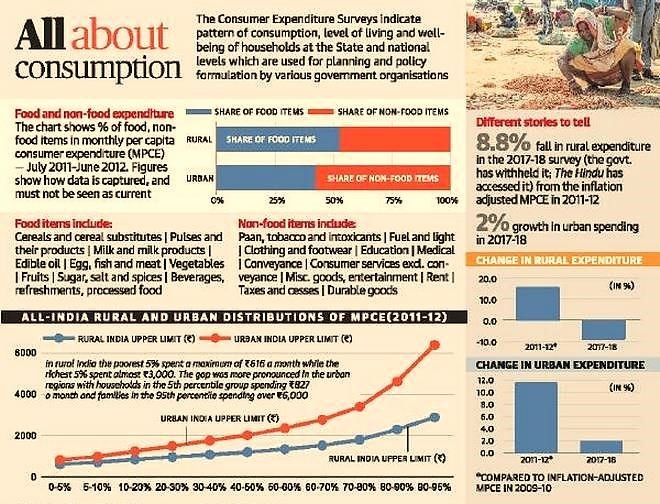Consumer Expenditure Survey
- The CES is aquinquennial (recurring every five years) survey conducted by the government’s National Sample Survey Office (NSSO) that is designed to collect information on the consumption spending patterns of households across the country, both urban and rural.
- The last survey on consumer expenditure was conducted in the 68th round (July 2011 to June 2012).

Source: The Hindu
Significance of CES
- Estimation of Monthly Per Capita Consumer Expenditure: The data gathered in this survey reveals the average expenditure on goods (food and non-food) and services and helps generate estimates of household Monthly Per Capita Consumer Expenditure (MPCE) as well as the distribution of households and persons over the MPCE classes.
- Assessing Living Standards and Growth: The estimates of monthly per capita consumption spending are vital in gauging the demand dynamics of the economy as well as for understanding the shifting priorities in terms of baskets of goods and services, and in assessing living standards and growth trends across multiple strata.
- Important Analytical and Forecasting Tool: It is an invaluable analytical as well as forecasting tool for the policymakers to spot and address possible structural anomalies that may cause demand to shift in a particular manner in a specific socio-economic or regional cohort of the population. It is, in fact, used by the government in rebasing the GDP and other macro-economic indicators.
National Statistical Office (NSO)
- The NSO is responsible for conduct of large scale sample surveys in diverse fields on All India basis. Primarily data are collected through nation-wide household surveys on various socio-economic subjects, Annual Survey of Industries (ASI), etc.
- It also collects data on rural and urban prices and plays a significant role in the improvement of crop statistics through supervision of the area enumeration and crop estimation surveys of the State agencies. It also maintains a frame of urban area units for use in sample surveys in urban areas.
|



